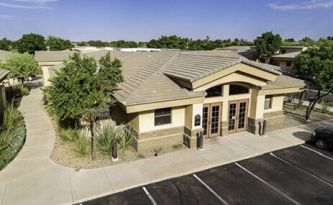Embryo / Sperm Freezing (Vitrification)
Arizona Center for Fertility Studies has been Cryopreserving (freezing) sperm since 1984. Later we added embryo and egg cryopreservation services, as well.
Arizona Center for Fertility Studies laboratory is equipped to receive and store cryopreserved sperm, embryos, and eggs from other clinics across the country and around the world. The tissue is stored in a secure place with state-of-the-art monitoring of each cryo tank. As cryo-technology has evolved over the years, it is now possible to store reproductive tissue for extended periods of time (years) and then thaw the cells for use at the desired time with high rates of success and live births.
Indications For Cryopreservation
Cryopreservation can be used to preserve the eggs of young single women and/or a woman in a committed relationship who has been diagnosed with cancer and will be undergoing treatment that could result in premature ovarian failure and who want to preserve their future childbearing potential.
The same is true for men who are diagnosed with cancer and are undergoing treatments that will permanently arrest spermatogenesis (production of sperm).
The most common use of cryopreservation is that it allows couples undergoing In-Vitro Fertilization (IVF) to freeze their extra embryos, which can be used for a second attempt if the first try of In-Vitro Fertilization (IVF) was unsuccessful or for future children without having to again undergo the entire ovarian stimulation process. Not only does it save them a considerable amount of expense; but in the case of wanting to have another child, they get to use their embryos from a cycle that worked and "when they were younger", thus improving success rates by decreasing the risks of chromosome abnormalities and miscarriage that can be associated with increasing maternal age.
Another indication for cryopreservation is when a woman has produced a large number of eggs and is at risk of OHSS, or ovarian hyperstimulation syndrome, which worsens with pregnancy. Rather than canceling the cycle, the eggs can be recovered and fertilized, and then all the embryos can be cryopreserved, allowing measures to be taken that will reduce the severity of OHSS which would normally interfere with getting pregnant. The embryos can then be transferred in a subsequent on-stimulated cycle without any risk of OHSS.
The Process of Cryopreservation
With current state-of-the-art cryo-technology at Arizona Center for Fertility Studies, embryos freeze and thaw extremely well. Arizona Center for Fertility Studies cryopreserves embryos at any stage of development but prefers to freeze either a day three or day five, blastocyst, embryo. Freezing at these stages appears to have the greatest success in thawing and producing ongoing pregnancies.
If the couple was doing ZIFT, embryos can successfully be frozen at the pronuclear stage (day 1) or the 4-cell stage (day 2). Cryopreservation does not seem to harm "good embryos" only "bad ones". In other words, if the embryo is of good quality going into the freeze, then when it is thawed, it should come out with the same good quality, and a good chance of achieving a pregnancy. Freezing, however, is "not kind" to poorer quality embryos, and if they are not good going into the freeze, they will not thaw well and, more than likely, not result in producing a pregnancy. There are a few articles in the literature that recommends that all embryos obtained on a fresh cycle be cryopreserved and not transferred. Then, on a subsequent, non-stimulated prepared cycle , the thinking is that only the "best of the best" embryos will survive the thaw and those are the ones that are transferred; thus, potentially increasing pregnancy rates. Although, in theory, this does have some validity, Arizona Center for Fertility Studies does not recommend this approach unless a couple only has cryopreserved embryos to use and is doing a FET (Embryo Transfer).
At Arizona Center for Fertility Studies, all embryos undergo vitrification - or rapid freezing, quickly down to -196°C, which is then stored in large containers of liquid nitrogen. Prior to starting the freezing process, depending on the age of the woman and the quality of the remaining embryos, 1-2 embryos are placed in an indelibly labeled straw surrounded by the cryoprotectant solution or "anti-freeze" and then sealed. The number of embryos placed in each straw is discussed with the couple prior to freezing and is based on not having to thaw more embryos than are needed on subsequent attempts at In-Vitro Fertilization (IVF). On each cryo cycle, there are always a few straws that only contain one embryo; because if one or more embryos from a multi-embryo straw do not survive the thaw and an additional embryo is needed, another multi-embryo straw will not have to be thawed just to get an additional embryo. The number of embryos cryopreserved in a straw depends on the number of embryos available for freezing and the number of embryos the ASRM guidelines recommend (In-Vitro Fertilization (IVF)), and the couple's plans on transferring with the next attempt. Once the embryos are frozen, the straws are attached to aluminum canes, that are again indelibly labeled with the patient's name and other identifying information, and are placed in sleeves in the nitrogen liquid tank. Site maps of each patient's location of their embryos, as well as all pertinent information about the embryos, in the specific cryo tank recorded in a computer database with print-out copies stored in a binder in the cryo lab, along with two backup disks; one which is kept on site and the other that is taken home by the embryologist. Inventory is checked on a regular basis to confirm proper labeling (over time the writing on indelibly labeled straws and canes can begin to fade and need to be relabeled), location, and number of straws remaining for each patient which has to exactly match the computer database. However, even with all these safeguards, the possibility of technical failure leading to the loss of stored embryos following a natural disaster cannot be totally and completely eliminated; although, to date, this has not occurred. Arizona Center for Fertility Studies has never misidentified, misplaced, or lost a single straw of cryopreserved reproductive tissue.
When the couple makes the decision to again attempt pregnancy, prior to thawing their embryos, all identifying information is checked and double-checked and must exactly match before the appropriate number of embryos are thawed. The embryos are thawed in a water bath at 30 degrees centigrade over several minutes. The embryos are then carefully rinsed to remove the cryoprotectant and placed back into the culture medium and returned to the incubator. At Arizona Center for Fertility Studies, we thaw the embryos out one hour before the transfer, allowing them to equilibrate from the freeze-thaw, and have the chance to make one cleavage or division, which is an excellent sign for the viability of that embryo. Arizona Center for Fertility Studies would like to see at least 80-90+% of the embryos survive (and even more if PGS testing was done) the thaw, with little to no increase in fragmentation from when it was frozen, in order to recommend that the embryo be transferred. All cryopreserved thawed embryos undergo assisted hatching about an hour before uterine transfer because scientific data has clearly shown that cryopreservation can artificially harden the zona pellucida or wall of an embryo, preventing it from "hatching" out when it is ready to implant.
A concern with cryopreservation is the potential risk of birth defects in children produced from frozen-thawed embryos. In the domestic animal industry, large-scale freezing and transfer of embryos have not resulted in increased birth defects. Studies to date on human babies born from cryopreserved, than thawed embryos, have not shown any statistical increase in birth defects or other abnormalities when compared to the rest of the population.
After a couple has completed childbearing and has remaining embryos, they must decide on the disposition of those embryos.
The Arizona Center for Fertility Studies consent for disposition of extra embryos. (PDF)











